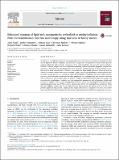Files in this item
Enhanced imaging of lipid rich nanoparticles embedded in methylcellulose films for transmission electron microscopy using mixtures of heavy metals
Item metadata
| dc.contributor.author | Asadi, Jalal | |
| dc.contributor.author | Ferguson, Sophie | |
| dc.contributor.author | Raja, Hussain | |
| dc.contributor.author | Hacker, Christian | |
| dc.contributor.author | Marius, Phedra | |
| dc.contributor.author | Ward, Richard | |
| dc.contributor.author | Pliotas, Christos | |
| dc.contributor.author | Naismith, James Henderson | |
| dc.contributor.author | Lucocq, John | |
| dc.date.accessioned | 2017-05-11T09:30:22Z | |
| dc.date.available | 2017-05-11T09:30:22Z | |
| dc.date.issued | 2017-08 | |
| dc.identifier | 249642134 | |
| dc.identifier | 2108482e-21f7-4964-bb65-16496b101ad0 | |
| dc.identifier | 85017527213 | |
| dc.identifier | 000402217600006 | |
| dc.identifier.citation | Asadi , J , Ferguson , S , Raja , H , Hacker , C , Marius , P , Ward , R , Pliotas , C , Naismith , J H & Lucocq , J 2017 , ' Enhanced imaging of lipid rich nanoparticles embedded in methylcellulose films for transmission electron microscopy using mixtures of heavy metals ' , Micron , vol. 99 , pp. 40-48 . https://doi.org/10.1016/j.micron.2017.03.019 | en |
| dc.identifier.issn | 0968-4328 | |
| dc.identifier.other | RIS: urn:0EAA2C4ED6D55B1E9673D85F2CF57DAA | |
| dc.identifier.other | ORCID: /0000-0002-4309-4858/work/34737683 | |
| dc.identifier.other | ORCID: /0000-0002-5191-0093/work/64361222 | |
| dc.identifier.uri | https://hdl.handle.net/10023/10746 | |
| dc.description | This work was supported by funds from the St Andrews EM facility and the University of St Andrews. CP is a Royal Society of Edinburgh (RSE) Personal Research Fellow, funded by the Scottish Government. CP is also supported by a Tenovus Scotland Award (T15/41). JML was supported by a Programme grant from the Wellcome Trust (Number 045404). | en |
| dc.description.abstract | Synthetic and naturally occurring lipid-rich nanoparticles are of wide ranging importance in biomedicine. They include liposomes, bicelles, nanodiscs, exosomes and virus particles. The quantitative study of these particles requires methods for high-resolution visualization of the whole population. One powerful imaging method is cryo-EM of vitrified samples, but this is technically demanding, requires specialized equipment, provides low contrast and does not reveal all particles present in a population. Another approach is classical negative stain-EM, which is more accessible but is difficult to standardize for larger lipidic structures, which are prone to artifacts of structure collapse and contrast variability. A third method uses embedment in methylcellulose films containing uranyl acetate as a contrasting agent. Methylcellulose embedment has been widely used for contrasting and supporting cryosections but only sporadically for visualizing lipid rich vesicular structures such as endosomes and exosomes. Here we present a simple methylcellulose-based method for routine and comprehensive visualization of synthetic lipid rich nanoparticles preparations, such as liposomes, bicelles and nanodiscs. It combines a novel double-staining mixture of uranyl acetate (UA) and tungsten-based electron stains (namely phosphotungstic acid (PTA) or sodium silicotungstate (STA)) with methylcellulose embedment. While the methylcellulose supports the delicate lipid structures during drying, the addition of PTA or STA to UA provides significant enhancement in lipid structure display and contrast as compared to UA alone. This double staining method should aid routine structural evaluation and quantification of lipid rich nanoparticles structures. | |
| dc.format.extent | 9 | |
| dc.format.extent | 3454863 | |
| dc.language.iso | eng | |
| dc.relation.ispartof | Micron | en |
| dc.subject | Bicelles | en |
| dc.subject | Phospholipids | en |
| dc.subject | Membranes | en |
| dc.subject | Lipids | en |
| dc.subject | Methylcellulose | en |
| dc.subject | Uranyl acetate | en |
| dc.subject | Phosphotungstic acid | en |
| dc.subject | Sodium silicotungstate | en |
| dc.subject | Negative stain | en |
| dc.subject | Liposomes | en |
| dc.subject | Nanodiscs | en |
| dc.subject | QD Chemistry | en |
| dc.subject | QH301 Biology | en |
| dc.subject | QR Microbiology | en |
| dc.subject | NDAS | en |
| dc.subject.lcc | QD | en |
| dc.subject.lcc | QH301 | en |
| dc.subject.lcc | QR | en |
| dc.title | Enhanced imaging of lipid rich nanoparticles embedded in methylcellulose films for transmission electron microscopy using mixtures of heavy metals | en |
| dc.type | Journal article | en |
| dc.contributor.sponsor | The Wellcome Trust | en |
| dc.contributor.sponsor | The Royal Society of Edinburgh | en |
| dc.contributor.sponsor | Tenovus-Scotland | en |
| dc.contributor.institution | University of St Andrews. School of Medicine | en |
| dc.contributor.institution | University of St Andrews. Biomedical Sciences Research Complex | en |
| dc.contributor.institution | University of St Andrews. School of Biology | en |
| dc.contributor.institution | University of St Andrews. School of Chemistry | en |
| dc.contributor.institution | University of St Andrews. EaSTCHEM | en |
| dc.contributor.institution | University of St Andrews. Cellular Medicine Division | en |
| dc.identifier.doi | 10.1016/j.micron.2017.03.019 | |
| dc.description.status | Peer reviewed | en |
| dc.identifier.url | http://europepmc.org/articles/PMC5465805 | en |
| dc.identifier.grantnumber | 089803/B/09/Z | en |
| dc.identifier.grantnumber | en | |
| dc.identifier.grantnumber | T15/41 | en |
This item appears in the following Collection(s)
Items in the St Andrews Research Repository are protected by copyright, with all rights reserved, unless otherwise indicated.

